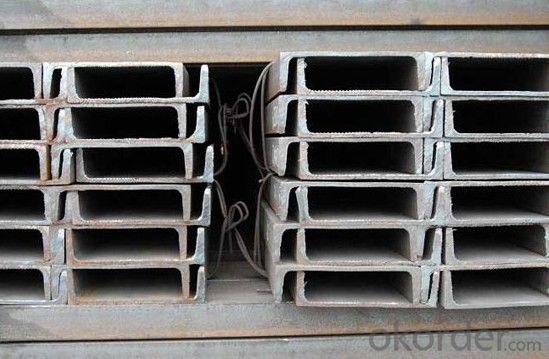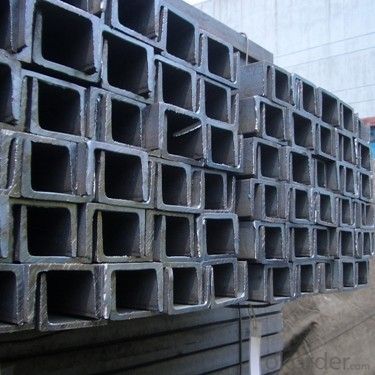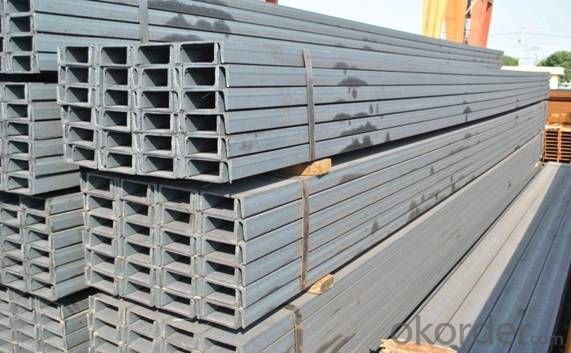50mm JIS Standard U Channels for construction
- Loading Port:
- Tianjin
- Payment Terms:
- TT OR LC
- Min Order Qty:
- 25 m.t.
- Supply Capability:
- 10000 m.t./month
OKorder Service Pledge
OKorder Financial Service
You Might Also Like
Product Applications:
Japanese Standard U-channels are ideal for structural applications and are widely used in the construction of buildings and bridges, and the manufacturing, petrochemical, and transportation industries.
Product Advantages:
OKorder's Japanese Standard U-channels are durable, strong, and resist corrosion.
Main Product Features:
· Premium quality
· Prompt delivery & seaworthy packing (30 days after receiving deposit)
· Corrosion resistance
· Can be recycled and reused
· Mill test certification
· Professional Service
· Competitive pricing
Product Specifications:
Manufacture: Hot rolled
Grade: Q195 – 235
Certificates: ISO, SGS, BV, CIQ
Length: 6m – 12m, as per customer request
Packaging: Export packing, nude packing, bundled
Product Applications:
Japanese Standard U-channels are ideal for structural applications and are widely used in the construction of buildings and bridges, and the manufacturing, petrochemical, and transportation industries.
Product Advantages:
OKorder's Japanese Standard U-channels are durable, strong, and resist corrosion.
Main Product Features:
· Premium quality
· Prompt delivery & seaworthy packing (30 days after receiving deposit)
· Corrosion resistance
· Can be recycled and reused
· Mill test certification
· Professional Service
· Competitive pricing
Product Specifications:
Manufacture: Hot rolled
Grade: Q195 – 235
Certificates: ISO, SGS, BV, CIQ
Length: 6m – 12m, as per customer request
Packaging: Export packing, nude packing, bundled
Quick Details
Place of Origin:Hebei, China (Mainland)
Material:Steel
technique:hot rolled
Standard:AISI,ASTM,BS,DIN,GB,JIS
thickness:3-9mm, 6-13mm
Application:Building construction
Width:50mm-300mm
Length:6m-12m or as your request
Shape:U shape
Material:Q235, SS400 etc
Normal Length:12m/6m
Packaging & Delivery
| Packaging Details: | according to the customer's request |
|---|---|
| Delivery Detail: | about 25-30 days after receive your payment |
Specifications
channel steel
1)Size: 51x25x3mm-305x80x13mm
2)Material: Q195,Q215,Q235,A36,SS400,SS540
3)Packing:bundle with strips



- Q:What are the disadvantages of using steel channels?
- There are a few disadvantages of using steel channels in certain applications. Firstly, steel channels tend to be heavy and bulky, which can make them difficult to handle and transport. This can add to the overall cost and complexity of a project. Additionally, steel channels are prone to corrosion and rusting, especially when exposed to moisture or harsh environmental conditions. This can lead to a decrease in structural integrity and a shorter lifespan for the channels. Regular maintenance and protective coatings may be required to mitigate this issue. Another disadvantage is that steel channels have limited versatility in terms of shape and size. They are typically available in standard shapes and sizes, which may not always be suitable for specific design requirements. Customization options can be limited and may come with additional costs. Furthermore, steel channels can be relatively expensive compared to other materials, especially if they are made from high-quality steel alloys. This can make steel channels less cost-effective for certain projects, especially when there are alternative materials that can fulfill the same purpose at a lower cost. Lastly, steel channels are poor insulators of heat and electricity. In applications where thermal or electrical conductivity is a concern, alternative materials may be more suitable. Overall, while steel channels offer many advantages such as strength and durability, it is important to consider these disadvantages before deciding to use them in a particular application.
- Q:What are the different installation techniques for steel channels?
- Steel channels can be installed in various ways, depending on their intended use and specific requirements. Here are a few commonly used techniques: 1. Welding: By utilizing a welding machine, the steel channels can be fused to the supporting structure, creating a sturdy connection between the two. 2. Bolting: An alternative method involves securing the steel channels to the supporting structure using bolts. This technique is particularly useful when adjustability or removal of the channels is necessary. 3. Adhesive bonding: In certain cases, steel channels can be installed by bonding them to the supporting structure using a strong adhesive. This method is suitable when welding or bolting is not feasible. 4. Mechanical fasteners: For lighter-duty applications or temporary installations, mechanical fasteners like screws, nails, or rivets can be used to affix the steel channels. 5. Sliding or sliding-fit installation: In specific scenarios, steel channels can be easily installed by sliding them into pre-formed slots or grooves in the supporting structure. This facilitates effortless installation and removal as required. When selecting the appropriate installation technique for steel channels, it is crucial to consider the project's specific requirements, such as load-bearing capacity, durability, and ease of installation. Seeking guidance from a structural engineer or construction professional is advisable to ensure the proper installation method is chosen for the particular application.
- Q:Can steel channels be used in temporary structures?
- Indeed, steel channels are well-suited for temporary structures. Due to their robustness and endurance, steel channels find widespread use in construction. Their adaptability allows for effortless assembly and disassembly, rendering them perfect for temporary structures. Notably, steel channels offer both structural reinforcement and stability, making them an optimal choice for temporary bridges, scaffolding, and shoring systems. Moreover, their ability to withstand diverse weather conditions and resist corrosion adds to their dependability when utilized in structures that may be exposed to the elements.
- Q:Can steel channels be used in commercial construction?
- Certainly! Steel channels have a wide range of applications in commercial construction. These versatile structural components are commonly utilized in the construction industry because of their strength, durability, and cost-effectiveness. They are frequently employed as support beams, columns, and framing elements in commercial buildings. Given their excellent load-bearing capabilities and ability to withstand heavy loads, steel channels are ideal for robust and reliable structural components needed in commercial construction projects. Moreover, steel channels can be easily customized to meet specific design requirements, providing construction flexibility. Overall, due to their strength, versatility, and suitability for various applications, steel channels are highly favored in commercial construction.
- Q:How do steel channels contribute to energy efficiency in buildings?
- Steel channels have multiple contributions to energy efficiency in buildings. Firstly, they are commonly used as structural components in building frames, providing stability and support. This allows for the construction of taller buildings with more open floor plans. By opting for steel channels instead of traditional materials like wood or concrete, the weight of the building is reduced, resulting in lower energy consumption during construction and transportation. Moreover, steel channels are renowned for their durability and strength. This strength enables the creation of longer spans and larger openings, optimizing natural lighting and ventilation in a building. By maximizing the utilization of natural light, the need for artificial lighting is diminished, leading to decreased energy consumption and cost. Similarly, enhanced natural ventilation reduces reliance on air conditioning systems, resulting in energy savings. Furthermore, steel channels can be integrated into the construction of energy-efficient building envelopes. These envelopes are designed to minimize heat transfer between the interior and exterior environment. Steel channels are commonly incorporated into the framing of walls, roofs, and floors, providing a robust and stable structure that supports insulation materials. This insulation helps maintain a comfortable indoor temperature year-round, reducing the necessity for heating or cooling systems and ultimately conserving energy. Lastly, steel channels are recyclable, contributing to the sustainability of a building. At the end of a building's lifespan, steel channels can be easily salvaged and recycled into new steel products. This reduces the demand for new materials and minimizes the carbon footprint associated with manufacturing new building materials. In conclusion, steel channels have a significant impact on improving energy efficiency in buildings. They achieve this by reducing construction weight, enabling natural lighting and ventilation, enhancing insulation capabilities, and promoting sustainability through recycling.
- Q:Are steel channels suitable for use in underground structures?
- Underground structures can benefit from the use of steel channels. These channels are frequently employed in construction due to their strength, durability, and versatility. When it comes to structures located underground, like tunnels or underground parking lots, steel channels offer several advantages. Firstly, steel channels possess a high load-bearing capacity. Robust support systems are typically necessary for underground structures to endure the pressure from surrounding soil or water. Steel channels are capable of evenly distributing the load, providing structural stability and preventing deformation or collapse. Secondly, steel channels are resistant to corrosion, which is particularly crucial in underground environments where moisture and high humidity levels are prevalent. Corrosion can weaken the structural integrity of materials, but steel channels coated with protective substances or constructed from stainless steel can withstand the harsh underground conditions. Additionally, steel channels can be easily fabricated and adjusted to meet specific design requirements, making them ideal for complex underground structures. They can be cut, welded, and shaped to fit various architectural needs, ensuring efficient installation and customization. Lastly, steel channels have a long lifespan and require minimal maintenance, reducing the overall cost and effort associated with underground structures. The durability of steel channels ensures that underground construction remains intact for an extended period, minimizing the need for repairs or replacements. In conclusion, steel channels are a suitable option for use in underground structures due to their strength, corrosion resistance, adaptability, and durability. These qualities make them an excellent choice for providing structural support and ensuring the longevity of underground constructions.
- Q:What are the different weight classifications for steel channels?
- The weight classifications for steel channels vary depending on the specific dimensions and designations, but common weight classifications include lightweight, medium weight, and heavy weight.
- Q:How do steel channels perform under cyclic loading?
- Steel channels generally perform well under cyclic loading. The structural integrity and durability of steel channels allow them to withstand repeated loading and unloading without significant deformation or failure. The robustness and high strength-to-weight ratio of steel make it an ideal material for withstanding cyclic loading, making steel channels a reliable choice in various applications, particularly in construction and engineering projects.
- Q:How do steel channels contribute to the overall versatility of a structure?
- Steel channels contribute to the overall versatility of a structure by providing a strong and flexible framework that can be easily customized and adapted to different design requirements. They allow for the creation of various structural configurations, such as beams, columns, and trusses, which can be adjusted in length, width, and depth as needed. This versatility enables architects and engineers to design structures with different spans, heights, and load-bearing capacities, making steel channels an essential component in constructing diverse and adaptable buildings and infrastructure.
- Q:6.3# how long is the channel length?
- Standard Specification for hot rolled plain channel steel:63*40*4.8 6.3# 6.635 KG/M channel measurement theoretical weight weight calculation theory for calculation of steel kg (kg). The basic formula is: W (weight, kg) = F (basal area mm2) * L (length m) * P (density g/cm3) * 1/1000 steel density: 7.85g/cm3.63**40 *4.8 6.3# 6.635
1. Manufacturer Overview |
|
|---|---|
| Location | |
| Year Established | |
| Annual Output Value | |
| Main Markets | |
| Company Certifications | |
2. Manufacturer Certificates |
|
|---|---|
| a) Certification Name | |
| Range | |
| Reference | |
| Validity Period | |
3. Manufacturer Capability |
|
|---|---|
| a)Trade Capacity | |
| Nearest Port | |
| Export Percentage | |
| No.of Employees in Trade Department | |
| Language Spoken: | |
| b)Factory Information | |
| Factory Size: | |
| No. of Production Lines | |
| Contract Manufacturing | |
| Product Price Range | |
Send your message to us
50mm JIS Standard U Channels for construction
- Loading Port:
- Tianjin
- Payment Terms:
- TT OR LC
- Min Order Qty:
- 25 m.t.
- Supply Capability:
- 10000 m.t./month
OKorder Service Pledge
OKorder Financial Service
Similar products
New products
Hot products
Related keywords





























